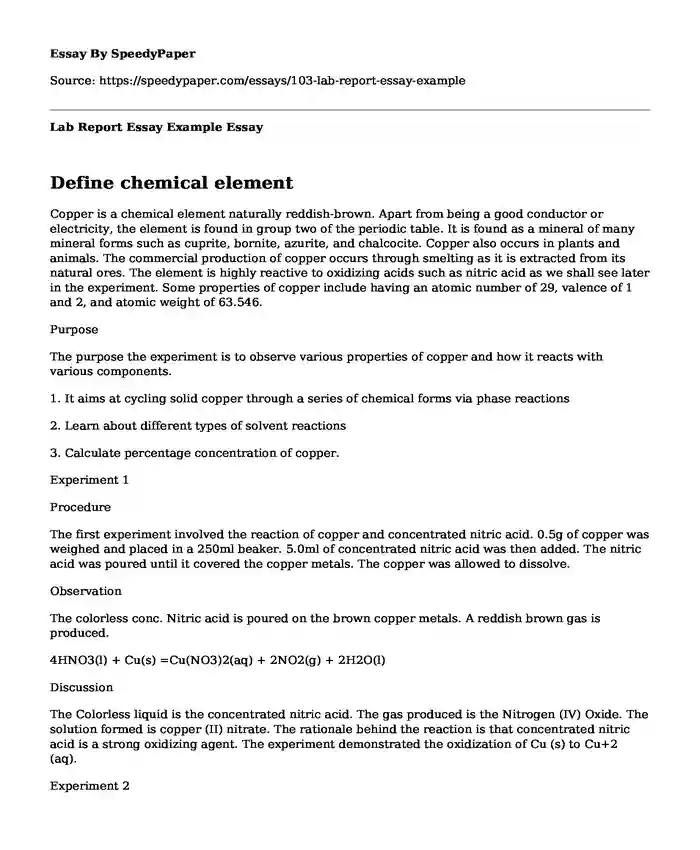Define chemical element
Copper is a chemical element naturally reddish-brown. Apart from being a good conductor or electricity, the element is found in group two of the periodic table. It is found as a mineral of many mineral forms such as cuprite, bornite, azurite, and chalcocite. Copper also occurs in plants and animals. The commercial production of copper occurs through smelting as it is extracted from its natural ores. The element is highly reactive to oxidizing acids such as nitric acid as we shall see later in the experiment. Some properties of copper include having an atomic number of 29, valence of 1 and 2, and atomic weight of 63.546.
Purpose
The purpose the experiment is to observe various properties of copper and how it reacts with various components.
1. It aims at cycling solid copper through a series of chemical forms via phase reactions
2. Learn about different types of solvent reactions
3. Calculate percentage concentration of copper.
Experiment 1
Procedure
The first experiment involved the reaction of copper and concentrated nitric acid. 0.5g of copper was weighed and placed in a 250ml beaker. 5.0ml of concentrated nitric acid was then added. The nitric acid was poured until it covered the copper metals. The copper was allowed to dissolve.
Observation
The colorless conc. Nitric acid is poured on the brown copper metals. A reddish brown gas is produced.
4HNO3(l) + Cu(s) =Cu(NO3)2(aq) + 2NO2(g) + 2H2O(l)
Discussion
The Colorless liquid is the concentrated nitric acid. The gas produced is the Nitrogen (IV) Oxide. The solution formed is copper (II) nitrate. The rationale behind the reaction is that concentrated nitric acid is a strong oxidizing agent. The experiment demonstrated the oxidization of Cu (s) to Cu+2 (aq).
Experiment 2
Procedure
The next procedure was to add 20ml 6M NaOH onto the sample from experiment 1 above.
Observation
There is the production of a light blue precipitate
Equation
CU(NO3)2(aq) + 2NaOH(aq) = Cu(OH)2(s) + 2NaNO3(aq)
Discussion
The light blue precipitate is the copper (II) hydroxide. The compound does not dissolve in water, for that reason, it forms a precipitate.
Experiment 3
Procedure involved putting the content f experiment 3 above in a hot water bath.
Observation
The blue precipitate changes to black
Equation
Cu(OH)2(s) + heat= CuO
Discussion
When Copper II Oxide is heated, it produces Copper II Oxide and water.
Experiment 4
Procedure
Dilute sulphuric acid is added to copper II oxide.
Observation
A blue solution is formed
CUO(s) + H2SO4(aq)= CUSO4(aq) + H20(l)
Discussion
The solution formed is called Copper II Sulphate. The reaction is neutralization reaction and involves a base and an acid.
Cite this page
Lab Report Essay Example. (2018, Mar 19). Retrieved from https://speedypaper.net/essays/103-lab-report-essay-example
Request Removal
If you are the original author of this essay and no longer wish to have it published on the SpeedyPaper website, please click below to request its removal:
- Free Essay in Marketing Management: A Case Study of the Centralian College
- Free Essay on Public Health Campaign on Social Media
- Free Essay Example on the U.S. Military Spending
- Fallacies in Advertisement, Essay Example for Everyone
- Role of Government in Tourism and Events, Essay Example for Students
- Free Essay about Causes of Anxiety in Adolescent
- Advertisement Messages of Nivea. Essay Example.
Popular categories





